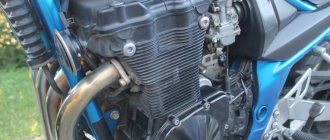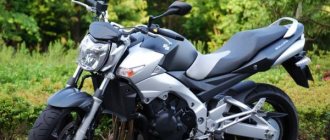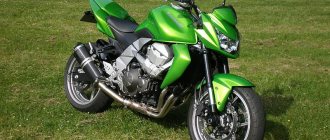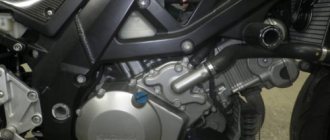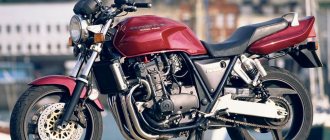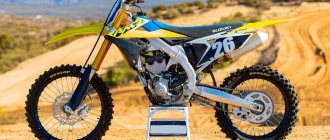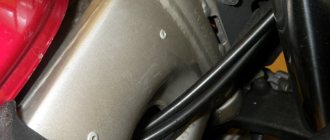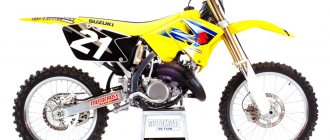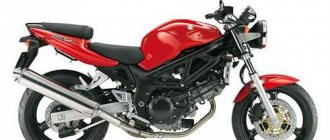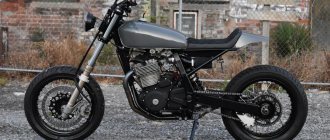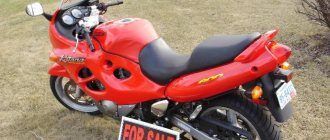At the end of the last century, Suzuki Design Bureau came up with the idea to offer the user a cheap Japanese motorcycle that could compete with the well-known Italian Ducati.
In 1999, the development was implemented and the Suzuki SV 650 was launched for export markets. At the same time, the SV 400, a model with a smaller cubic capacity, was being developed for domestic markets. The motorcycle is not created from a “blank slate”; many solutions are honed on the previously released Suzuki TL1000 .
000_moto_0712_054
Suzuki SV650: naked, 1999 - 2002, 645 cm³, 69 hp, 130,000 - 180,000 rub.
Suzuki SV650: naked, 1999 - 2002, 645 cm³, 69 hp, 130,000 - 180,000 rub.
STORY. Suzuki has been exploiting the theme of motorcycles with two-cylinder V-twins for a long time. The company first drew attention to its large V-twins with the TL1000S, then released the more flexible TL1000R. By 1999, the concept had changed, and a completely new motorcycle was released - the Suzuki SV650.
At first glance, the device was made with a clear eye on the Ducati Monster - a tubular frame in the manner of the legendary “birdcage” (but not steel, like the Italian’s, but aluminum) and a V-twin engine (more precisely, in full accordance with the Italian “icon” , here it is L-shaped) with a displacement of “six hundred and a little.” But Suzuki went further. In addition to the “naked” motorcycle, the SV650S model was presented to the public - with a “two-eyed” half-fairing and a more “sporty” riding position, and in the UK the SV650S Sport version was sold - with a full fairing. In addition, the domestic Japanese version of the “esveshka” - Suzuki SV400 - is well represented on the Russian market. The differences lie in the size of the engine displacement (as the name suggests, the motorcycle for the home market had 400 cc), one brake disc instead of two, and the absence of a yoke behind the passenger seat. Later, however, the designers did not save so much, and a second brake disc appeared on the SV400.
The novelty was received with a bang by the public. Of course, moderate weight, high-quality suspension and a high-torque engine, combined with a low price, ensured the popularity of the SV650. The two-cylinder engine with a displacement of 645 cm³ did not have exorbitant power, but, unlike in-line fours, it allowed you to drive confidently from the lowest revs. The buyer could choose between the classic upright riding position of the stripped version and the sportier SV650S. The engine is not particularly voracious, and the 16-liter gas tank provides the Esveshka with a good power reserve.
The motorcycle turned out to be in demand both for beginners and for those who needed a simple and unpretentious means of transportation in the metropolis. Even those who like to sharpen sliders on the track did not ignore the “esveshka”. Moreover, mono cups were held in a number of countries for SV650 owners, and in the USA this motorcycle became the most popular machine at track days. By the way, there is one curious thing associated with the sale of the SV650 in the States: in the American market in 1999, only the “naked” version was available; The SV650S was sold in neighboring Canada and Europe. By 2000, Suzuki had corrected this situation.
In 2002, Suzuki finally took care of the issue of adjusting the SV650 suspension - now you can adjust the degree of spring preload on the fork (before that there were no adjustments to the front suspension).
In 2003, a new generation of SV650 saw the light, which received an injection engine and a cast aluminum frame, but we will talk about these motorcycles another time.
Peculiarities
The bike immediately received 2 modifications, subsequently another one, and was produced for 12 years, until 2012.
There were two main modifications - a “stripped” naked model and a “two-eyed” version with a fairing.
During this time, it experiences 1 major restyling, as well as minor changes, every three years .
The model turned out to be quite interesting, and in 2021 Suzuki will announce the return of the famous model, but with a new filling. It was dubbed SV 650 2016+.
003_moto_0712_054
2003. Production of the second generation Suzuki SV650 began.
2003. Production of the second generation Suzuki SV650 began.
FOR WHAT? For life. The SV650 is a motorcycle that is equally well suited for both city dwellers and suburbanites. The light and narrow motorcycle squeezes through iron boxes without any problems; the brake capabilities are quite sufficient at reasonable speeds. The high-torque engine of the “esveshka” allows you to calmly “vomit” in city traffic jams, but the dynamics of the motorcycle are also up to par, thanks in part to its low weight. Taking the SV650 to a karting track is by no means contraindicated. Moreover, it is on a slow and technical track that the ESV has every chance to “break” heavier competitors with in-line “fours”. The SV650S can also be used for long-distance travel. Its arsenal includes a comfortable fit, acceptable wind protection, a tolerable level of vibration and a good power reserve.
WHERE TO LOOK? Finding a first-generation SV650 is not difficult. There are many offers on the market, most of which are from private owners. Sometimes you can find “esveshki” from 1999–2002 in motorcycle showrooms, but this is rather a disappearing phenomenon - it’s easier to find a second-generation device there.
If you want to become the owner of a first-generation SV650, and even without mileage in the Russian Federation, you should contact companies that deliver custom-made equipment - there are still a lot of these motorcycles on the markets of both the USA and Europe.
TUNING. A motorcycle with a classic layout provides perhaps the widest field for realizing desires and fantasies. You can try to build a streetfighter, a sportbike, and a tourist from it. The set of components required for tuning the SV650 will depend on the direction of creativity. There is, of course, a certain basic set of aftermarket parts, the installation of which is practiced by most device owners.
Sliders (2-5 thousand rubles) are placed in the frame without any difficulties, in the event of a fall, significantly increasing the chances of keeping the radiator and engine covers intact. You can approach the issue of protection more thoroughly by equipping your motorcycle with arches. This will cost 4–6 thousand rubles, but will significantly reduce the chances of damaging the frame in the event of an unsuccessful fall. A combined option - arches with sliders from the Russian company Crazy Iron - just under 6 thousand rubles.
The SV650's engine sound is very muted. And the “source” is so beautiful that it’s worth letting one enjoy the bass roar surrounding it. To do this, you just need to replace the heavy standard muffler with a direct-flow “end”. The money to “voice” the “esveshka” will require from 6 to 15–20 thousand rubles, depending on the name of the manufacturer and the amount of additional “hp” promised.
It is a good idea to replace the standard brake hoses with reinforced ones. Besides the fact that the original parts from 1999–2002 are clearly not in the best condition, this will help to somewhat improve the performance of the brakes. A set of reinforced hoses from Galfer, Goodridge or Venhill will cost 5–8 thousand rubles.
A simple change of the front tire can have a positive effect on the controllability of the vehicle. Installing a slightly higher profile tire 120/70–17 (the original one is 120/60–17) changes the behavior of the device for the better.
If we talk about more serious tuning of the motorcycle, then it’s worth taking care of refining the rather primitive suspensions. The SV650 front fork is either completely devoid of adjustments or allows only adjustment of the degree of spring preload. You can change the characteristics of the fork by selecting the oil, as well as replacing the springs with “progressive” ones (3-6 thousand rubles, excluding the cost of work and oil). A kit from Race Tech that simulates the operation of a cartridge fork will cost 8–10 thousand rubles, but its installation will require additional costs, since it will be necessary to drill holes in the rods and increase the diameter of existing ones. There are many options for replacing the rear monoshock, from used ones on the GSX-R to new Ohlins or Fox. The budget, accordingly, is from 10 to 30 thousand rubles.
If you want to go long-distance with the SV650, you can prepare the motorcycle for this according to the classical scheme. Install a windshield on a “naked” SV650 (3-6 thousand rubles) or replace the windshield with a “touring” one on an SV650S (price is about the same). Install heated handles - Oxford (3.5–4.5 thousand rubles) or Saito (2.5–3.5 thousand rubles). And add a bag for the tank (2.5–10 thousand rubles).
And on the SV650 you can install a fairing “plow” - from a small piece of plastic covering the exhaust and oil filter, to a full-fledged fairing element that turns the SV560S into a fully cowled motorcycle. The price of this plastic is from 4 to 8 thousand rubles.
PRICES. Despite the unprecedentedly low level of retail prices for new “ESVs” in the showrooms of European and North American dealers in the late 90s, in Russia used SV650s can hardly be classified as ultra-budget motorcycles. Nevertheless, prices for first-generation devices usually fluctuate in the range of 130–180 thousand rubles, that is, almost at the level of domestic Japanese “four hundred”.
By the way, there are quite a few SV400s on sale, but I personally don’t see the point in buying such a device: at almost the same price (“four hundred” of these years cost 110–170 thousand rubles), you get a motorcycle with an engine of much more than modest displacement, and often also with a “defective” single-disc brake. Such devices will be of interest only to those who still convince themselves of the exceptional quality of equipment produced for the domestic market.
CHOICE. The Suzuki SV650 is a virtually problem-free motorcycle, so the checklist is small. The list of places that should be paid attention to when choosing a device is standard, but there are several nuances.
The first step is to understand (or even directly ask) whether the owner liked to wheelie. The fact is that the SV650 does this very willingly, but such exercises have a detrimental effect on its health. When driving for a long time in a wheelie, due to oil starvation of the front cylinder, the liners rotate, which leads to the replacement of the connecting rod and crankshaft.
It should also be remembered that the timing chain tensioner design of the first generation SV650 engines leaves much to be desired. In principle, the “ticking” of the timing belt at low speeds is the norm for this engine, but if the sounds are loud enough (this is especially evident when closing the throttle and resetting the speed), then the engine is in danger of replacing a “stuck” tensioner or even a stretched chain.
It is worth paying attention to the condition of the relay regulator, although it does not fail so often. You can determine that the relay-regulator is not healthy by looking at the lower brightness of the headlights at idle than when the engine is off. It can be treated by replacement, and the sooner the better, otherwise you may end up having to replace the battery and generator.
Occasionally the contact on the dashboard and in the headlight connectors disappears. This can be treated by disassembling, cleaning and treating with appropriate auto chemicals.
In view of the special popularity of the SV650 as a road-ring machine, there is a high chance of running into a motorcycle that has had time to race to its heart’s content on overseas tracks. It is quite difficult to determine this externally; in this case, the original plastic is changed to “blind” and returned back before being sold. You should be wary of the presence of racing brake pads, high wear of brake discs (or, conversely, new discs), an abundance of tire marks on the rims and the presence of small holes in the oil and coolant filler caps (usually a wire is passed through them to prevent spontaneous unscrewing). It is also worth inspecting the air filter housing for additional holes.
Don't forget to also check the condition of the front cylinder exhaust pipe and the engine crankcase in the oil filter area. They are not protected by anything from below, and a banal drive over the curb can lead to damage.
A number of motorcycles manufactured in 2000 (with frame numbers JS1AV111200101536–102366 on the SV650S and JS1AV133200100776–100997 on the SV650) were affected by a recall campaign related to the oil pump sucking air, which led to increased wear on the crankshaft. So don't be lazy to check the numbers.
Veronica: “I didn’t have much choice”
— I always wanted to ride a motorcycle, my cousin had one. I went to study because my husband wanted a motorcycle, and I decided that I wanted one too. It's been four years since I've been on two wheels.
Before that I had a Kawasaki Ninja 250. My first motorcycle, it’s very cool, just great for a beginner. And for the second season, my husband gave me his Suzuki, because he bought himself a BMW, so there wasn’t much choice.
Compared to the Kawasaki, this Suzuki is much heavier and taller. My first motorcycle was very maneuverable, but it had very short gears - in the city you had to click them constantly. And on a Suzuki you can almost drive half of Minsk in first or second.
In terms of response to the throttle, the Suzuki is quite sharp and “undermines”. The brakes are good and stops amazing.
I like the fit, my back doesn’t hurt even after trips of 300 kilometers. I don’t accelerate much, but at speeds of 100-120 there is enough wind protection. Only the braid on his helmet dangles.
On the highway, fuel consumption is approximately 5-6 liters per “hundred”. I don’t feel any special vibrations at speed, I don’t feel wobbles, the motorcycle rides smoothly even at 100-120. It's soft, doesn't knock anything off, it's comfortable for me.
This year we don’t travel together as often as in the past - after all, it’s quarantine, we stayed at home. I don’t ride very much on a motorcycle during the season, about five thousand at most. This year the season generally opened late, only in May - the weather was not very good. I usually close in October.
I fell on this motorcycle once, it was last season. I went to motogymkhana and fell during training, which was very disappointing. The speed was very low, only the rear turn signal was broken. Since then I haven’t gone to gymkhana - it was very cool there in the Ninja, but it’s harder to turn in the SV at low speed.
What's not to like? Color - I would like light blue or red. I had a Ninja 250 just like this, I really liked the color. But here I like long passes, the speed is quite enough for me. At traffic lights, motorists like to chase me, sometimes I give in to provocations. But in general I’m a calm driver, I don’t like to race.
What will I change to if I have to? Perhaps a 650cc jixer, something like that. It's nice, has ABS, more recent than this SV.
012_moto_0712_054
| Estimated cost of consumables and spare parts | ||
| Name | Original spare parts, rub. | Non-original spare parts, rub. |
| Oil filter | 590 | 300 — 450 |
| Air filter | 1742 | 1200 — 4200 |
| Front brake pads | 4270 | 1200 — 1800 |
| Rear brake pads | 2588 | 1200 — 1400 |
| Chain + sprocket kit | 17000 | 6000 — 12000 |
| Brake/clutch levers | 2900 — 3050 | 400 — 3000 |
| Frame sliders | — | 2000 — 4000 |
COMPETITORS.
Driving performance
The maximum declared speed of the naked version was 195 km/h . As the owners said, it’s difficult to refute, because without wind protection you can’t go more than 120 km/h .
The second modification (sport claim) is 203 km/h .
Third, last - 209 km/h .
The dynamics, according to users, are beyond praise - 3.7 seconds to 100 km .
Consumption ranges from 4 liters to 7 liters depending on driving style and year of manufacture of the motorcycle. Most users agree at around 5 liters per 100.
Modifications
The motorcycle was produced in 3 official and one additional modifications.
Since the beginning of production, 2 main ones were produced, in 2008 a third appeared, which lasted on the assembly line for only a year, until 2009.
in 2009, regardless of the third official one, an additional one will be launched for the US markets.
The main ones are:
- SV650 - Naked version . Basic model. Closed in 2009.
- SV650S - Sport version . Second main model. Lower handlebars, higher footpegs, greater demand and the model lasts until the end of production. Closed in 2012.
- The third main modification lived only a year on the assembly line. Full fairing, wind protection, additional electronics. Started in 2008, closed in 2009.
Additional development
SFV650 Gladius . Produced based on the components of the main model. In the USA it became a full-fledged separate model. Closed in 2015 .
Suzuki SV line
The SV line includes three models.
- SV 400 - Japanese version. Copy of model 650.
- SFV650 - export version (described).
- SFV1000 - launched in 2003 as an older sister, but in pursuit of lower costs it did not receive an injector, SDTV, or instrument updates. It was not in great demand and was closed in 2007 .
Competitors
Honda Bros 650.
Honda CBF 600.
Kawasaki ER6.
There are three models listed as competitors for the bike:
- Honda Bros 650 (aka NTV 650 Revere, NT650 Hawk GT). features 3 valves per cylinder, 5-speed gearbox, 1 brake disc per axle.
- Honda CBF 600 . 4 cylinder engine, Combi brakes and ABS in stock, height adjustable windshield.
- Kawasaki ER-6 (aka Ninja 650R, ER-6n). Steel frame, production until 2021, consumption up to 5 liters - according to user reviews.
Dimensions and weight
The dry weight of the bike produced in 2000 is 165 kg .
It is the same for the 2012 model - 172 kg .
ABS and full charging with all fluids increased the weight by 25 kg . Model 2012 - 198 kg .
The dimensions of the bike changed from 2 to 4 times during evolution;
- the bike has grown in length - from 2,070 to 2,085 mm;
- lost weight in width - from 750 to 730 mm;
- also increased in height - from 1,060 to 1,170 mm ;
- the wheelbase has become smaller - from 1,430 to 1,425 mm ;
- seat height - from 805 to 800 mm ;
- ground clearance - from 140 to 155 mm .
For whom is it intended?
Designed for export, a low saddle, and special grooves for the knees will most likely guarantee a comfortable ride for bikers of medium and short stature.
Easy to ride and quite nimble, the bike will definitely appeal to beginners.
Advantages
The Suzuki SV 650, while not anything special, is simply a good motorcycle, reliable and reasonably priced.
But there are no less advantages:
- reliability;
- moderate fuel consumption;
- the ability to shoot between the rows;
- good headlight;
- excellent brakes.
And of course, the main qualities for a motorcycle are excellent handling and maneuverability.
